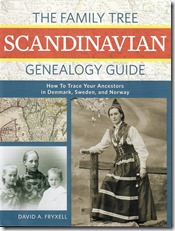 Title: The Family Tree Scandinavian Genealogy Guide
Title: The Family Tree Scandinavian Genealogy Guide
Author: David A. Fryxell
Format: Paperback
Published: 2019
My Rating: ![]()
![]()
![]()
![]()
The following review first appeared in the Federation of Genealogical Societies FORUM magazine (Fall 2020); reprinted with permission.
This post contains affiliate links.
The Family Tree Scandinavian Genealogy Guide is a wonderful resource for anyone with Scandinavian heritage. In this book, David A. Fryxell covers how to research ancestors from Denmark, Norway, and Sweden.
The book is organized into four parts. In the first part, readers will learn about the various waves of immigration and where Scandinavians settled. Also included in this part are basic research methods, as well as strategies for determining the origin of an ancestor using US-based records and emigration records.
In part 2, there is a chapter for each of the three Scandinavian countries. Each chapter provides a short history along with a handy timeline of key dates. I found this part very helpful as I really didn’t know much about Scandinavian history and found it quite interesting.
Part 3, chapters 7 through 14, makes up the bulk of this book. First, in chapter 7, Fryxell discusses the jurisdictions in each country. Knowing this background is necessary for locating records.
Chapter 8 provides a nice overview of the Scandinavian alphabet, particularly the extra letters and how they are recorded/filed alphabetically. There is also a sidebar that shows the reader how to type the letters on the computer. The reader will also find a handy table of common genealogical words such as birth, death, wife, and child, in all three languages. Handwriting is covered briefly, explaining that the Gothic Script (a.k.a. Old German Script) can be found among the records in all three countries. The bulk of the chapter covers Scandinavian names, which includes discussions on patronymics, farm names, and given name naming patterns.
The remainder of part 3 covers various types of records. Here, the reader will learn how to find and use the following records: church, census, probate, military, newspapers, directories, tax, cemetery, other court records, and nobility pedigrees. Differences in these records among the three countries is noted. Fryxell directs the reader to online records and resources when available.
The last part brings everything together and offers additional techniques for solving tough research problems. Three short case studies demonstrate many of the strategies and records presented in the book.
In addition to an index, readers will find five appendixes. The first contains various resources; the second contains tips for writing requests for records including sample record requests in Danish, Norwegian, and Swedish; the third contains word lists for months and numbers; the fourth contains a list of archives; and the fifth contains a handful of worksheets, one of which is a handy name variation worksheet.
Overall, Fryxell covers a lot of ground across three similar, yet different, countries. There are sample images of various record types, as well as tip boxes scattered throughout to alert the reader to things such as abbreviations used in census records. This will certainly be a welcome resource to anyone researching their Scandinavian roots.


Share your thoughts...